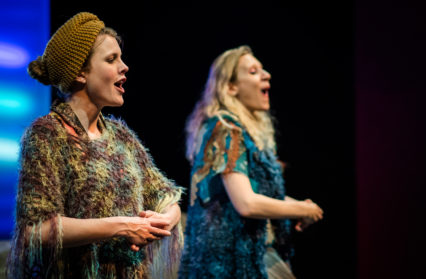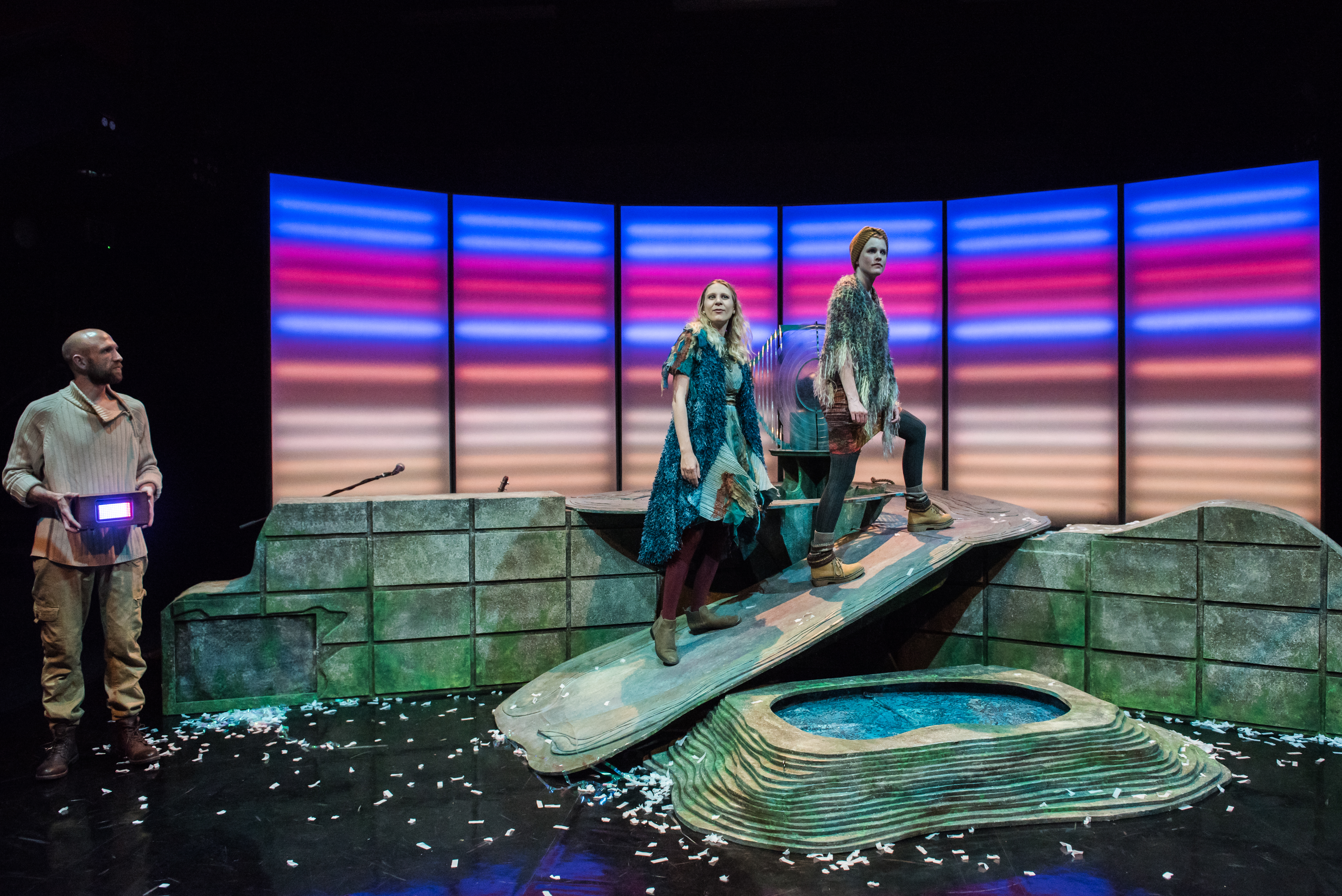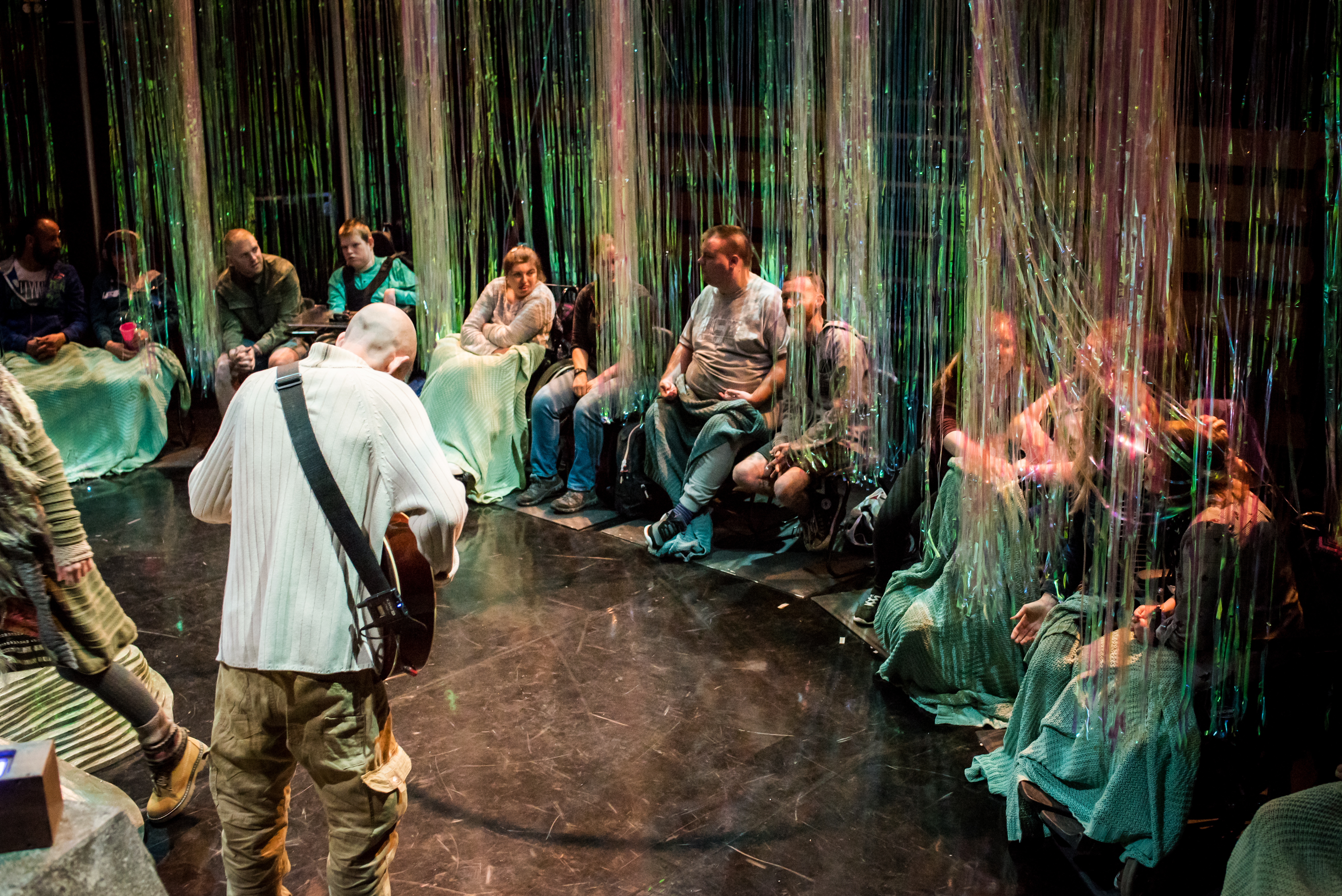With The Isle of Brimsker, a show devised specifically for audiences with profound and multiple learning disabilities (PMLD), Frozen Light hope to offer more people with PMLD the chance to experience the theatre. The Isle of Brimsker has been structured to provide an accessible environment which responds to the needs of their audience members by being performed at a close proximity, to small groups and with strong sensory and participation elements. Exploring friendship, isolation and how we react to change, The Isle of Brimsker immerses audiences with PMLD in a multi-sensory story of discovery. Gary Raymond caught up with co-Artistic Director and performer Lucy Garland as the tour got under way.
Firstly, could you explain a little about what you mean by multi-sensory, immersive theatre?
Frozen Light make theatre specifically for audiences with profound and multiple learning disabilities, therefore for the work to be accessible to them it needs to be multi-sensory as the majority of our audience access the world through the multi-sensory. What this means in terms of our productions is that every part of the story is punctuated with a sensory interaction. We perform to small audiences of 6 people with PMLD and their companions which allows the performers to have individual one to one interactions with each audience member with learning disabilities. These interactions form a non-verbal conversation between us and the audience.
And how does this relate specifically to the latest production, The Isle of Brimsker?
In The Isle of Brimsker we were really interested to explore other ways our audience can access sound and music other than just hearing it, so in the show we have used a lot of vibration and lights which represent the sound. The Isle of Brimsker is set on a remote island in the midst of the north sea and lots of our sensory interactions explore the landscape of the island, so for example the space smells like rock pools when the audience enters, they feel a platter of different temperature shells and stones and experience a dance music storm complete with rain, waves and snow.
Could you tell us a little about any specific challenges that have come up when bringing this show together, and also when selling the idea of this kind of theatre to an audience in general?
This is our fourth show and I feel like in this production we really got the rehearsal process spot on. We ensured the set and sensory props arrived early in the process so that we had plenty of time to explore them and ensure we were using them to their full sensory potential. It can be challenging to pre-empt how our audience are going to react to certain props or elements of the story and so we work with an audience panel of people with PMLD and their parents/companions who provide us with feedback during the rehearsal process. We also learn so much when we finally take the show out to an audience and are constantly learning and adapting our performance to the needs of the audience we have in on any given day. The audience very much guide us within the structure of the piece of theatre.
As a company we only work in theatre venues as we are passionate about our audience being able to access theatre in their local professional theatre venue. This does come with challenges though as sometimes theatres have never interacted with people with PMLD before. People with PMLD are one of the most invisible groups of people in society and are very often forgotten about. For a theatre venue to programme a piece of art specifically for this group and put it in their brochure alongside other mainstream productions shows our audience that they are valued as members of society and deserve to access art as much as anybody else. In terms of the challenges it can often be very difficult to reach our audience as they are rarely regular theatre goers. We employ an audience development assistant four days a week who works closely with the venues to support them in reaching our audience. Once we have reached those audiences, we see tour after tour that we have a huge percentage of returning audiences and a tour of sold out shows.
The Isle of Brimsker explores ideas of friendship, isolation, but also how people react to change – can you tell us a little bit more about how these ideas are developed in the play?
When we devise our shows, we turn theatre making on its head. We start with what multi-sensory aspects we want to explore and use in the production, we then create an environment and theme for these to exist in. Once we have this environment and sensory ideas, we build a story and characters around it.
In The Isle of Brimsker we wanted to look at ideas of change and transition. Our audience are frequently young adults and they are often having to transition from education (a school they are likely to have been in since they were 4 years old) to adult services which are often much more poorly funded and less consistent than educational establishments. Also, in the current climate our older adult audiences are more increasingly being moved from their homes/usual care provision due to cost saving exercises. We are always really interested in our productions following an emotional narrative and wanted to explore the theme of transition in a safe space and an accessible way relevant to the needs of our audience.
How did you research the ideas behind setting this play in a lighthouse?
When we initially looked at exploring sound and vibrations we spent a lot of time looking at sound waves, which in turn led us to ocean waves. We were interested in the cyclical nature of the tide and the place where the sea meets the land. The question then was how this can involve characters and the idea of a lighthouse was born.
How do you go from identifying themes that are important to your core mission statement as a company, and turning that into a play about people?
As a company we specifically make work for adults and young adults with profound and multiple learning disabilities. It is really important to us that our work is age appropriate as well as accessible for our audience. As a company we are passionate about story and believe that everyone has the right to access stories, because life is stories and theatre mirrors life. We therefore like to build important universal themes into our work and layer them with music, multi-sensory interaction and signing to ensure that there is a myriad of ways that our audience can access the narrative and follow the emotional journey.
And has the mainstream attitude toward productions for audiences with PLMD improved in recent years? And is there still a long way to go until the idea that “theatre is for everyone” is a slogan commonly repeated at venues around the country?
This is our fourth tour to theatre venues across the country and with every tour we reach more and more venues, with The Isle of Brimsker touring to 54 venues across the UK. This shows a massive commitment from these venues to programme work that reaches an audience otherwise not catered for. The more we tour the more word spreads about our work and the demand for it from our audience. I do think there is still a long way to go as if we are not touring there is very little else our adult audience with PMLD can access, but I definitely think things are moving forward.
I also think it is very difficult to put all theatre venues into the same categories. We have venues that have supported us and our audience from the beginning and now have a loyal and hungry following of people with PMLD and their companions who actively return to that venue time and time again. These are generally venues that are embedded in their local communities, those who understand that their venue is there to serve their local community and the audiences in it. They are also often venues that are making steps towards a diverse programme and better access. But there are still many venues that have a long, long way to go, but if they are willing to try, we are always open to conversations and will support those venues in what they need to do to open their doors to our audiences.
I also want to mention the difference it makes to our audience if the venue we are touring to has a changing places toilet. Many of our audience members are wheelchair users, to be able to use a standard disabled toilet you need to be able to transfer from your wheelchair onto the toilet and the majority of our audience are unable to do this. This means that they need a toilet with a hoist and a change bench. These toilets can make the difference to our audience of whether they can travel to our production or not. If a venue has a changing places it means our audience will find it much easier and more comfortable to access our productions and anything else relevant in that building.
For more information check out: http://www.changing-places.org/
(Images courtesy of JLM Photography)





 Enjoyed this article? Support our writers directly by buying them a coffee and clicking this link.
Enjoyed this article? Support our writers directly by buying them a coffee and clicking this link.








